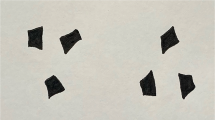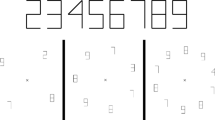Abstract
This study examined the effects of attention on forming perceptual units by proximity grouping and by uniform connectedness (UC). In Experiment 1 a row of three global letters defined by either proximity or UC was presented at the center of the visual field. Participants were asked to identify the letter in the middle of stimulus arrays while ignoring the flankers. The stimulus onset asynchrony (SOA) between stimulus arrays and masks varied between 180 and 500 ms. We found that responses to targets defined by proximity grouping were slower than to those defined by UC at median SOAs but there were no differences at short or long SOAs. Incongruent flankers slowed responses to targets and this flanker compatibility effect was larger for UC than for proximity-defined flankers. Experiment 2 examined the effects of spatial precueing on discrimination responses to proximity- and UC-defined targets. The advantage for targets defined by UC over targets defined by proximity grouping was greater at uncued relative to cued locations. The results suggest that the advantage for UC over proximity grouping in forming perceptual units is contingent on the stimuli not being fully attended, and that paying attention to the stimuli differentially benefits proximity grouping.
Similar content being viewed by others
References
Wertheimer, M., Untersuchungen zur Lehre von der Gestalt: II, Psychologische Forshung, 1923, 4: 301–350.
Han, S., Humphreys, G. W., Chen, L., Uniform connectedness and classical Gestalt principles of perceptual grouping, Perception & Psychophysics, 1999, 61: 661–674.
Han, S., Humphreys, G. W., Interactions between perceptual organization based on Gestalt laws and those based on hierarchical processing, Perception & Psychophysics, 1999, 61: 1287–1298.
Palmer, S., Rock, I., Rethinking perceptual organization: The role of uniform connectedness, Psychonomic Bulletin & Review, 1994, 1: 29–55.
Van Lier, R., Wagemans, J., Effects of physical connectivity on the representational unity of multi-part configurations, Cognition, 1998, 69: 1–9.
Saiki, J., Hummel, J. E., Connectedness and the integration of parts with relations in shape perception, Journal of Experimental Psychology: Human Perception and Performance, 1998, 24: 227–251.
Watson, S. E., Kramer, A. F., Object—based visual selective attention and perceptual organization, Perception & Psychophysics, 1999, 61: 31–49.
Han, S., Humphreys, G. W., Chen, L., Parallel and competitive processes in hierarchical analysis: Perceptual grouping and encoding of closure, Journal of Experimental Psychology: Human Perception and Performance, 1999, 25: 1411–1432.
Kimchi, R., The perceptual organization of visual objects: A microgenetic analysis, Vision Research, 2000, 40: 1333–1347.
Han, S., Humphreys, G. W., Relationship between uniform connectedness and proximity in perceptual grouping, Science in China, Ser. C, 2003, 46(2): 113–126.
Eriksen, B. A., Eriksen, C. W., Effects of noise letters upon the identification of a target letter in a nonsearch task, Perception & Psychophysics, 1974, 16: 143–149.
Miller, J., Priming is not necessary for selective-attention failures: Semantice effects of unattended, unprimed letters, Perception & Psychophysics, 1987, 41: 419–434.
Yantis, S., Johnston, J. C., On the locus of visual selection: Evidence from focused attention tasks, Journal of Experimental Psychology: Human Perception and Performance, 1990, 16: 135–149.
Schmid, P. A., Dark, V. J., Attentional processing of “unattended” flankers: Evidence for a failure of selective attention, Perception & Psychophysics, 1998, 60: 227–238.
Miller, J., Priming is not necessary for selective-attention failures: Semantice effects of unattended, unprimed letters, Perception & Psychophysics, 1987, 41: 419–434.
Johnston, W. A., Dark, V. J., In defense of intraperceptual theories of attention, Journal of Experimental Psychology: Human Perception and Performance, 1982, 8: 407–421.
Kahneman, D., Treisman, A., Changing views of attention and automaticity, in Varieties of Attention (eds. Parasuraman, R., Davies, D.R.), New York: Academic Press, 1984, 29–61.
Posner, M. I., Orienting of attention, Quarterly Journal of Experimental Psychology, 1980, 32: 3–25.
Eriksen, C. W., The flanker task and response competition: A useful tool for investigating a variety of cognitive problems, Visual Cognition, 1995, 2: 101–118.
Baylis, G. C., Driver, J., Visual parsing and response competition: The effect of grouping factors, Perception & Psychophysics, 1992, 51: 145–162.
Duncan, J., Humphreys, G. W., Visual search and stimulus similarity, Psychological Review, 1989, 96: 433–458.
Moore, C. M., Egeth, H., Perception without attention: Evidence of grouping under conditions of inattention, Journal of Experimental Psychology: Human Perception and Performance, 1997, 23: 339–352.
Gilbert, M., Ito, M., Kapadia, M., Westheimer, G., Interactions between attention, context and learning in primary visual cortex, Vision Research, 2000, 40: 1217–1226.
Ben-Av, M. B., Sagi, D., Braun, J., Visual attention and perceptual grouping, Perception & Psychophysics, 1992, 52: 277–294.
Gerlach, C., Aaside, C. T., Humphreys, G. W., Gade, A., Paulson, O., Law I. Brain activity related to integrative processes in visual object recognition: Bottom-up integration and the modulatory influence of stored knowledge, Neuropsychologia, 2002, 40: 1254–1267.
Han, S., Song, Y., Ding, Y., Yund, E. Y., Woods, D. L., Neural substrates for visual perceptual grouping in human, Psychophysiology, 2001, 38: 926–935.
Author information
Authors and Affiliations
Corresponding author
Rights and permissions
About this article
Cite this article
Han, S., Humphreys, G.W. Perceptual organization at attended and unattended locations. Sci. China Ser. C.-Life Sci. 48, 106–116 (2005). https://doi.org/10.1007/BF02879663
Received:
Revised:
Issue Date:
DOI: https://doi.org/10.1007/BF02879663




